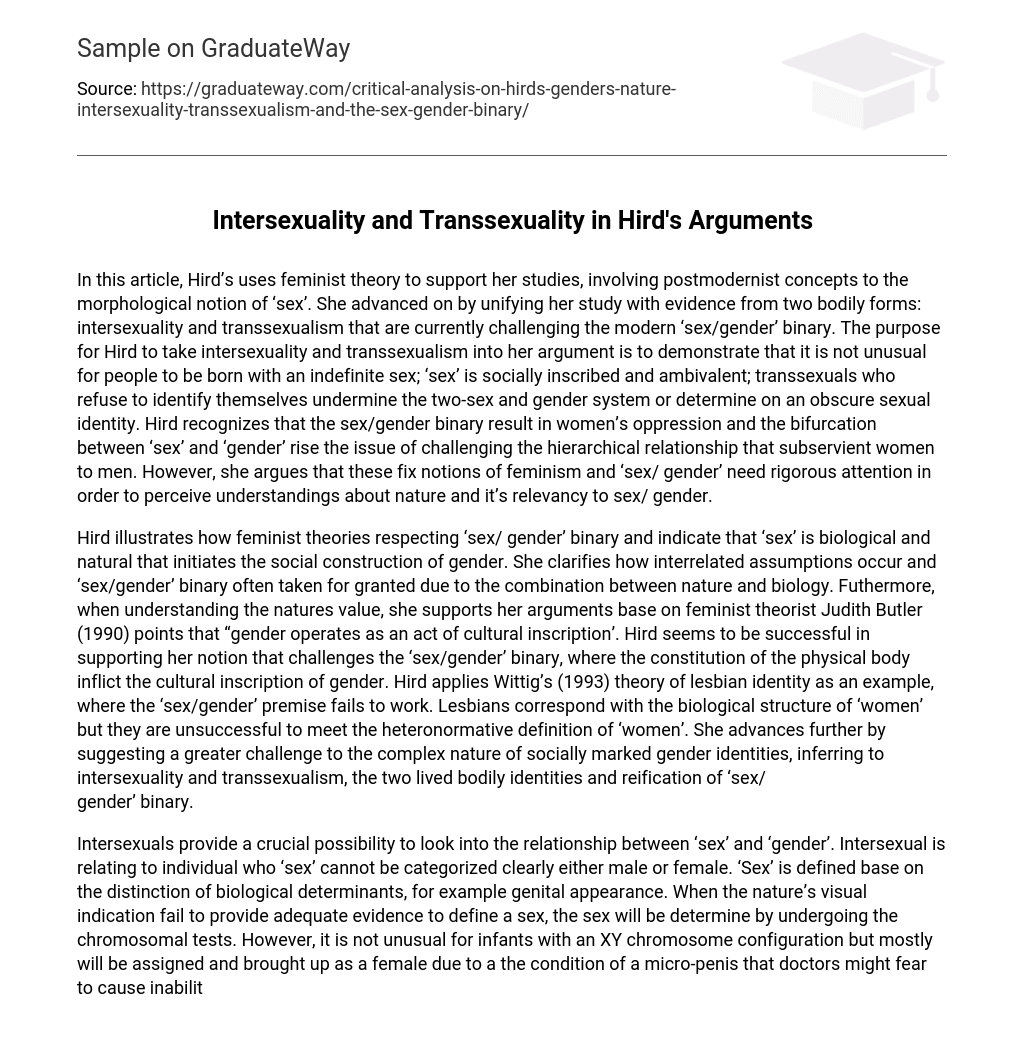In this article, Hird employs feminist theory to substantiate her research, incorporating postmodernist ideas to redefine the concept of ‘sex’. She expands on her study by referring to evidence from intersexuality and transsexualism, both challenging the traditional ‘sex/gender’ binary. Hird’s goal is to illustrate that it is not uncommon for individuals to be born with an indeterminate sex; ‘sex’ is a socially constructed and ambiguous notion. Transsexual individuals who reject societal expectations undermine the existing two-sex and gender system by embracing an obscure sexual identity. Hird acknowledges that the sex/gender binary oppresses women, and the distinction between ‘sex’ and ‘gender’ emphasizes the necessity of questioning the hierarchical relationship that subjugates women to men. However, she argues that these fixed notions of feminism and ‘sex/gender’ demand thorough examination in order to further comprehend nature’s relevance to sex/gender.
Hird explores feminist theories related to the ‘sex/gender’ binary and its impact on the social construction of gender. She emphasizes the importance of questioning the assumption that sex is natural, as this belief reinforces the concept of a binary system. To support her perspective, Hird references Judith Butler (1990), who argues that culture plays a significant role in shaping gender. By demonstrating how cultural norms determine gender based on physical traits, Hird effectively challenges the ‘sex/gender’ binary. One example she uses is Wittig’s (1993) theory on lesbian identity, which shows that lesbians may identify as biologically female but do not conform to heteronormative definitions. Furthermore, Hird expands her argument to explore complex socially constructed gender identities such as intersexuality and transsexualism, both of which defy the rigid ‘sex/gender’ binary.
Intersex individuals offer an important opportunity to examine the relationship between ‘sex’ and ‘gender’. Intersexuality refers to individuals whose biological characteristics do not clearly fit into male or female categories. Determining someone’s sex is typically based on visual cues, like genital appearance; however, in cases where these cues are insufficient, chromosomal tests are conducted.
In certain situations, infants with XY chromosomes may be assigned and raised as females due to a condition called micro-penis. This decision aims to prevent potential functional issues that might arise if they were identified as males later in life. This example emphasizes how relying solely on nature’s indications may not always provide enough information to determine one’s sex, as stated by Hird in her article.
Hird also examines male-to-female (MTF) transsexuals who feel trapped in the wrong body. She challenges the belief held by some transsexuals that a true understanding of themselves as women can only be achieved within societal systems. According to her argument, this perpetuates ‘gender essentialism’.
Similarly, Beauvoir (1953) asserts that active participation in the lived experience of being a woman is necessary for fully comprehending the significant aspects of womanhood and becoming one. Hird disagrees with this idea but argues that it perpetuates a definition focused on sex/gender while ignoring the ongoing development of gender identities.According to Hird (2000, p.353), the authenticity of sex is crucial in his study, highlighting that it is not inherent in the body but rather stems from distinct systems of power, knowledge, and truth.
Applying Butler’s (1990) concept of performativity, the author argues that gender is influenced rather than essential to one’s identity. This queer theory challenges the belief that a sex change indicates a change in gender; instead, it asserts that it is an assertion of identity and self-knowledge. In line with early feminist ideas, the author suggests that gender is individualistic and biology plays a lesser role. The author explores the orientation of male-to-female transsexuals to challenge society’s binary understanding of sex and gender, emphasizing how societal responses impact decisions regarding sex change operations. While this perspective may not be widely accepted by other feminist theorists who view “sex” as socially constructed, the author engages with queer theorists who emphasize the multifaceted nature of gender and sexuality while explicitly highlighting the limitations of a binary approach to “sex/gender.” The author utilizes intersexuality to validate their argument against heteronormative definitions reliant on sex as a biological and natural foundation for defining gender.Despite this, the author successfully emphasizes the constraint of understanding “sex/gender” when it comes to transsexual individuals. This draws attention to the division that already exists within transsexualism. Ultimately, the author proposes that by examining intersexuals and transsexuals, we can gain a deep understanding of how the sex/gender binary is interconnected.
Reference
– Hird.J.M.(2000), Gender’s nature: Intersexuality,transsexualism and the sex gender binary, sage





